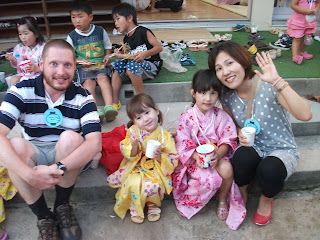お盆 Obon is a Buddhist festival . It is usually celebrated around August 15th for three days. I live in Yonago city, Totttori prefecture in Western Japan. This year in 2009, it is celebrated on August 13th, 14th, and 15th, with the main Obon day in the middle. It is sometimes referred to as the “Day of the dead”, but I think this is misleading. True, it has to do with departed spirits and the TV and newspapers are full of ghost stories. In this sense it is similar to Halloween or Mexico’s “Day of the Dead”. However, at it’s core, there is nothing macabre about Obon. It is a solemn but festive occasion. The purpose of the festival is to honor and pray for the family’s ancestors. It is the time of year when the spirit of the departed family members return to Earth and the home for a visit.
Religion

There are two main religions in Japan that most people adhere to. Shinto (native to Japan) and Buddhism (introduced from India via China). There is an expression in Japanese, “Born Shinto, die Buddhist.” This means that Shinto shrines mainly deal with ceremonies of life; birth, christening type ceremonies, ceremonies of good luck before a big event like a sports game or test, and marriages. Buddhist temples mainly deal with funeral rites and memorial ceremonies. With rare exceptions, funerals are never Shinto. Many homes have both a small household Shinto shrine (yashiro) and a family Buddhist alter (butsudan) and pray to both of them all year round. People pray to the yashiro and the Shinto Kami or god that protects the family and community. They pray to the Butsudan for the ancestors and place ceremonial food offerings such as rice, sweets, or alcohol.. During Obon the butsudan is the center of attention. Obon is a time for praying for the ancestor and many households have a Buddhist priest visit the house and perform a short memorial ceremony. Needless to say this is a very busy time for temples, but also very important for generating revenue. Prices vary, but an approximately 30 minute ceremony in the home can cost upwards of $500.00 (this is what my wife’s parents pay in a small town) and with 20 to 30 home visits a day, this can add up fast; not to mention all the people who visit the temple directly.
Feast of Lanterns


Obon is also called the Feast of Lanterns. Japanese people visit their family graves and wash the stones, place flowers and incense and pray. Next to all Buddhist graves is a stone lantern(Torou). These lanterns are only lit once a year on the three nights of Obon to show the spirits have returned. Families place a small candle inside and put rice paper over the openings. My wife thinks I’m strange, but Japanese cemeteries are really beautiful at this time with all the lights. In addition, in some areas at the end of Obon, they lite small paper lanterns and float them down the river to send the spirits back home.
Horse and Cow?
Another interesting custom is the making of a little horse and cow by using a cucumber and eggplant respectively. People simply take a cucumber and eggplant and stick them with four disposable chopsticks to make legs. On the first day of Obon, the vegetable animals are placed outside at the front gate or door and incense is lit. Why a cow and horse? Well, the ancestor’s spirits ride them between this world and the other. The trail of incense smoke helps the spirits find their way home. After the first day, the animals are placed on the butsudan and given ceremonial food offerings once a day. I saw them there this morning at my wife’s parent’s house. On the last day they are taken and set on the river bank to signify returning to the world of the dead. You never throw them into the water.
Hungry Ghosts
People are happy to have the ancestors back, but there are a lot of bad spirits or hungry ghosts out there too. The term hungry ghosts comes from China and means restless spirits that have no one to perform ceremonies for them. These ghosts are considered dangerous and are believed to cause sickness or death. In China, there is a whole month dedicated to appeasing these spirits. There are some notable don’ts during Obon.
1. Don’t go to the beach or swim in the ocean or lakes or rivers. The spirits of the dead will pull you down and drown you.
2. Don’t go hiking in the mountains. The ghosts will cause you to get lost and try to harm you.
3. Don’t kill any insects, especially butterflies or spiders. They might be the reincarnated spirits of your relatives. I asked my wife if I was ok to kill mosquitos or cockroaches. I kind of got a no comment. No one wants to think of Grandma coming back as a cockroach.
Obon Dance
The climax of Obon is the Bon dance or Bon-Odori. There is a large, tall, square stage set up with festive banners of red and white and paper lanterns strung all around. The singers and musicians play on the stage and the spectators are encouraged to dance around the stage to the music waving their arms in the air. It is one of the biggest and most traditional events of the year for Japanese. The festival usually ends with a fireworks display.













































